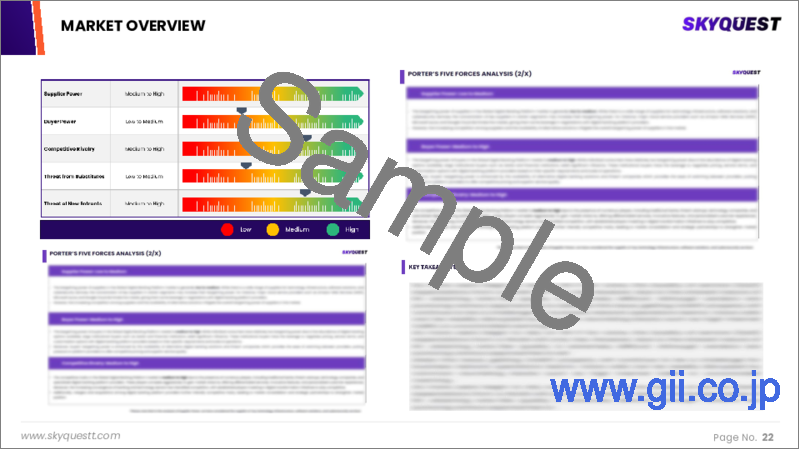|
|
市場調査レポート
商品コード
1614827
エッジデータセンター市場規模、シェア、成長分析、コンポーネント別、組織規模別、エンドユーザー産業別、場所別、用途別、地域別-2024年~2031年産業予測Edge Data Center Market Size, Share, Growth Analysis, By Component (Solutions, Services), By Organization Size (Large Enterprises, SMEs), By End User Industry, By Location, By Application, By Region - Industry Forecast 2024-2031 |
||||||
|
|||||||
| エッジデータセンター市場規模、シェア、成長分析、コンポーネント別、組織規模別、エンドユーザー産業別、場所別、用途別、地域別-2024年~2031年産業予測 |
|
出版日: 2024年12月13日
発行: SkyQuest
ページ情報: 英文 187 Pages
納期: 3~5営業日
|
全表示
- 概要
- 目次
エッジデータセンターの世界市場規模は、2022年に93億3,000万米ドルと評価され、2023年の110億5,000万米ドルから2031年には426億6,000万米ドルに成長し、予測期間中(2024年~2031年)のCAGRは18.4%で成長する見通しです。
エッジデータセンターは、クラウドコンピューティングリソースやキャッシュされたコンテンツをローカルエンドユーザーに近づけることで、ネットワーク環境に革命をもたらしています。このようなエネルギー効率の高い構造は、ITおよび通信インフラを強化し、待ち時間を短縮したより高速なサービスを実現します。特に、迅速なデータ処理に依存する金融やヘルスケアなどの業界にとって不可欠なエッジデータセンターは、ネットワーク中断のリスクを軽減し、ネットワークのパフォーマンスとセキュリティを強化します。これらの施設をエンドユーザーの近くに設置することで、企業はコストのかかるインフラ拡張を回避しながら、有利な市場を効果的に狙うことができます。継続的な進歩により、エッジデータセンターは従来の集中型クラウド・ネットワークに代わる魅力的な選択肢となっており、企業が運用の最適化とサービス提供の強化を目指す中、当面の市場シェアは大きく拡大する見通しです。
目次
イントロダクション
- 調査の目的
- 調査範囲
- 定義
調査手法
- 情報調達
- 二次データと一次データの方法
- 市場規模予測
- 市場の前提条件と制限
エグゼクティブサマリー
- 世界市場の見通し
- 供給と需要の動向分析
- セグメント別機会分析
市場力学と見通し
- 市場概要
- 市場規模
- 市場力学
- 促進要因と機会
- 抑制要因と課題
- ポーター分析と影響
- 競争企業間の敵対関係
- 代替品の脅威
- 買い手の交渉力
- 新規参入業者の脅威
- 供給企業の交渉力
主な市場の考察
- 重要成功要因
- 競合の程度
- 主な投資機会
- 市場エコシステム
- 市場の魅力指数(2023年)
- PESTEL分析
- マクロ経済指標
- バリューチェーン分析
- 価格分析
- 技術の進歩
- 規制情勢
- 特許分析
- ケーススタディ
エッジデータセンター市場規模:コンポーネント別& CAGR(2024年~2031年)
- 市場概要
- ソリューション
- ハードウェア
- サーバー
- ストレージ
- ネットワーク機器
- ソフトウェア
- データセンターインフラストラクチャ管理(DCIM)
- セキュリティソリューション
- サービス
- インストールと統合
- マネージドサービス
- コンサルティングサービス
エッジデータセンター市場規模:組織規模別& CAGR(2024年~2031年)
- 市場概要
- 大企業
- 中小企業
エッジデータセンター市場規模:エンドユーザー産業別& CAGR(2024年~2031年)
- 市場概要
- ITおよび通信
- 銀行金融サービス保険(BFSI)
- ヘルスケア
- 小売り
- 製造業
- エネルギー
- 政府
エッジデータセンター市場規模:場所別& CAGR(2024年~2031年)
- 市場概要
- 都会
- 田舎
エッジデータセンター市場規模:用途別& CAGR(2024年~2031年)
- 市場概要
- モノのインターネット(IoT)
- 人工知能(AI)
- コンテンツ配信
- スマートシティ
- 自動運転車
エッジデータセンター市場規模& CAGR(2024年~2031年)
- 北米
- 米国
- カナダ
- 欧州
- 英国
- ドイツ
- スペイン
- フランス
- イタリア
- その他欧州
- アジア太平洋
- 中国
- インド
- 日本
- 韓国
- その他アジア太平洋
- ラテンアメリカ
- ブラジル
- その他ラテンアメリカ
- 中東・アフリカ
- GCC諸国
- 南アフリカ
- その他中東・アフリカ
競合情報
- 上位5社の比較
- 主要企業の市場ポジショニング(2023年)
- 主な市場企業が採用した戦略
- 市場の最近の動向
- 企業の市場シェア分析(2023年)
- 主要企業の企業プロファイル
- 会社概要
- 製品ポートフォリオ分析
- セグメント別シェア分析
- 収益の前年比比較(2021年~2023年)
主要企業プロファイル
- Cisco Systems Inc
- Dell Technologies Inc.
- Hewlett Packard Enterprise Development LP(HPE)
- Huawei Technologies Co., Ltd.
- IBM Corporation
- Schneider Electric SE
- Vertiv Group Corp.
- Eaton Corporation
- Fujitsu Limited
- Nokia Corporation
- Equinix, Inc.
- Digital Realty Trust, Inc.
- EdgeConneX
- Vapor IO
- 6WIND
- ADLINK Technology Inc.
- AT&T Inc.
- Crown Castle International Corp.
- EdgeMicro
- Flexential Corp.
結論と推奨事項
Global Edge Data Center Market size was valued at USD 9.33 billion in 2022 and is poised to grow from USD 11.05 billion in 2023 to USD 42.66 billion by 2031, growing at a CAGR of 18.4% during the forecast period (2024-2031).
Edge data centers are revolutionizing the network landscape by bringing cloud computing resources and cached content closer to local end users. These energy-efficient structures enhance IT and communication infrastructures, resulting in faster services with reduced latency. Particularly indispensable for industries like finance and healthcare that rely on rapid data processing, edge data centers mitigate the risks of disruptions, bolstering network performance and security. By situating these facilities nearer to end users, businesses can effectively target lucrative markets while avoiding costly infrastructure expansion. With ongoing advancements, edge data centers present a compelling alternative to traditional, centralized cloud networks, positioning themselves for significant market share growth in the foreseeable future, as organizations seek to optimize operations and enhance service delivery.
Top-down and bottom-up approaches were used to estimate and validate the size of the Global Edge Data Center market and to estimate the size of various other dependent submarkets. The research methodology used to estimate the market size includes the following details: The key players in the market were identified through secondary research, and their market shares in the respective regions were determined through primary and secondary research. This entire procedure includes the study of the annual and financial reports of the top market players and extensive interviews for key insights from industry leaders such as CEOs, VPs, directors, and marketing executives. All percentage shares split, and breakdowns were determined using secondary sources and verified through Primary sources. All possible parameters that affect the markets covered in this research study have been accounted for, viewed in extensive detail, verified through primary research, and analyzed to get the final quantitative and qualitative data.
Global Edge Data Center Market Segmental Analysis
Global Edge Data Center Market is segmented by component, organization size, end user industry, location, application and region. Based on component, the market is segmented into solutions (hardware, software) and services (installation and integration, managed services, consulting services). Based on organization size, the market is segmented into large enterprises and small and medium-sized enterprises (SMEs). Based on end user industry, the market is segmented into it and telecom, banking, financial services, and insurance (BFSI), healthcare, retail, manufacturing, energy and government. Based on location, the market is segmented into urban and rural. Based on application, the market is segmented into internet of things (IoT), artificial intelligence (AI), content delivery, smart cities and autonomous vehicles. Based on region, the market is segmented into North America, Europe, Asia Pacific, Latin America and Middle East & Africa.
Driver of the Global Edge Data Center Market
The rollout of 5G technology serves as a crucial driver for the Global Edge Data Center market. This fifth generation of wireless communication promises unprecedented advancements, including significantly enhanced data transfer speeds, reduced latency, and increased network capacity. Such improvements will facilitate the connection of a vast number of devices, allowing for innovative applications across multiple industries. By superseding the capabilities of the previous 4G/LTE technology, 5G is set to revolutionize mobile telecommunications, thereby fostering demand for edge data centers that are essential for processing and delivering data efficiently in real-time, ultimately transforming how businesses operate in a connected world.
Restraints in the Global Edge Data Center Market
The Global Edge Data Center market faces significant restraints primarily due to the stringent adherence to regulations. Given the decentralized nature of these data centers, they must navigate a complex array of local, state, federal, and international laws governing data processing and storage. Regulations such as the California Consumer Privacy Act (CCPA) in the US, the Personal Data Protection Act (PDPA) in Singapore, and the General Data Protection Regulation (GDPR) in the EU impose rigorous standards on the collection, processing, retention, and disclosure of personal data. This regulatory landscape complicates operations and creates challenges for compliance across different regions, impacting market growth.
Market Trends of the Global Edge Data Center Market
The Global Edge Data Center market is experiencing a robust upward trajectory fueled by an escalating demand for low-latency solutions. As enterprises increasingly require real-time data processing and storage capabilities at the network edge, innovations are proliferating in tandem with technological advancements like IoT, autonomous vehicles, and AI-driven analytics. This shift is changing how businesses leverage data, enabling them to enhance operational efficiency and responsiveness. The integration of edge computing not only reduces latency but also optimizes data handling, making it vital for industries such as healthcare, manufacturing, and finance. Consequently, this trend is poised to redefine the architectural landscape of data centers globally.
Table of Contents
Introduction
- Objectives of the Study
- Scope of the Report
- Definitions
Research Methodology
- Information Procurement
- Secondary & Primary Data Methods
- Market Size Estimation
- Market Assumptions & Limitations
Executive Summary
- Global Market Outlook
- Supply & Demand Trend Analysis
- Segmental Opportunity Analysis
Market Dynamics & Outlook
- Market Overview
- Market Size
- Market Dynamics
- Driver & Opportunities
- Restraints & Challenges
- Porters Analysis & Impact
- Competitive rivalry
- Threat of substitute
- Bargaining power of buyers
- Threat of new entrants
- Bargaining power of suppliers
Key Market Insights
- Key Success Factors
- Degree of Competition
- Top Investment Pockets
- Market Ecosystem
- Market Attractiveness Index, 2023
- PESTEL Analysis
- Macro-Economic Indicators
- Value Chain Analysis
- Pricing Analysis
- Technological Advancement
- Regulatory Landscape
- Patent Analysis
- Case Studies
Global Edge Data Center Market Size by Component & CAGR (2024-2031)
- Market Overview
- Solutions
- Hardware
- Servers
- Storage
- Networking Equipment
- Software
- Data Center Infrastructure Management (DCIM)
- Security Solutions
- Services
- Installation and Integration
- Managed Services
- Consulting Services
Global Edge Data Center Market Size by Organization Size & CAGR (2024-2031)
- Market Overview
- Large Enterprises
- Small & Medium-sized Enterprises (SMEs)
Global Edge Data Center Market Size by End User Industry & CAGR (2024-2031)
- Market Overview
- IT & Telecom
- Banking, Financial Services, and Insurance (BFSI)
- Healthcare
- Retail
- Manufacturing
- Energy
- Government
Global Edge Data Center Market Size by Location & CAGR (2024-2031)
- Market Overview
- Urban
- Rural
Global Edge Data Center Market Size by Application & CAGR (2024-2031)
- Market Overview
- Internet of Things (IoT)
- Artificial Intelligence (AI)
- Content Delivery
- Smart Cities
- Autonomous Vehicles
Global Edge Data Center Market Size & CAGR (2024-2031)
- North America, (Component, Organization Size, End User Industry, Location, Application)
- US
- Canada
- Europe, (Component, Organization Size, End User Industry, Location, Application)
- UK
- Germany
- Spain
- France
- Italy
- Rest of Europe
- Asia-Pacific, (Component, Organization Size, End User Industry, Location, Application)
- China
- India
- Japan
- South Korea
- Rest of Asia Pacific
- Latin America, (Component, Organization Size, End User Industry, Location, Application)
- Brazil
- Rest of Latin America
- Middle East & Africa, (Component, Organization Size, End User Industry, Location, Application)
- GCC Countries
- South Africa
- Rest of Middle East & Africa
Competitive Intelligence
- Top 5 Player Comparison
- Market Positioning of Key Players, 2023
- Strategies Adopted by Key Market Players
- Recent Developments in the Market
- Company Market Share Analysis, 2023
- Company Profiles of All Key Players
- Company Details
- Product Portfolio Analysis
- Company's Segmental Share Analysis
- Revenue Y-O-Y Comparison (2021-2023)
Key Company Profiles
- Cisco Systems Inc
- Company Overview
- Business Segment Overview
- Financial Updates
- Key Developments
- Dell Technologies Inc.
- Company Overview
- Business Segment Overview
- Financial Updates
- Key Developments
- Hewlett Packard Enterprise Development LP (HPE)
- Company Overview
- Business Segment Overview
- Financial Updates
- Key Developments
- Huawei Technologies Co., Ltd.
- Company Overview
- Business Segment Overview
- Financial Updates
- Key Developments
- IBM Corporation
- Company Overview
- Business Segment Overview
- Financial Updates
- Key Developments
- Schneider Electric SE
- Company Overview
- Business Segment Overview
- Financial Updates
- Key Developments
- Vertiv Group Corp.
- Company Overview
- Business Segment Overview
- Financial Updates
- Key Developments
- Eaton Corporation
- Company Overview
- Business Segment Overview
- Financial Updates
- Key Developments
- Fujitsu Limited
- Company Overview
- Business Segment Overview
- Financial Updates
- Key Developments
- Nokia Corporation
- Company Overview
- Business Segment Overview
- Financial Updates
- Key Developments
- Equinix, Inc.
- Company Overview
- Business Segment Overview
- Financial Updates
- Key Developments
- Digital Realty Trust, Inc.
- Company Overview
- Business Segment Overview
- Financial Updates
- Key Developments
- EdgeConneX
- Company Overview
- Business Segment Overview
- Financial Updates
- Key Developments
- Vapor IO
- Company Overview
- Business Segment Overview
- Financial Updates
- Key Developments
- 6WIND
- Company Overview
- Business Segment Overview
- Financial Updates
- Key Developments
- ADLINK Technology Inc.
- Company Overview
- Business Segment Overview
- Financial Updates
- Key Developments
- AT&T Inc.
- Company Overview
- Business Segment Overview
- Financial Updates
- Key Developments
- Crown Castle International Corp.
- Company Overview
- Business Segment Overview
- Financial Updates
- Key Developments
- EdgeMicro
- Company Overview
- Business Segment Overview
- Financial Updates
- Key Developments
- Flexential Corp.
- Company Overview
- Business Segment Overview
- Financial Updates
- Key Developments






